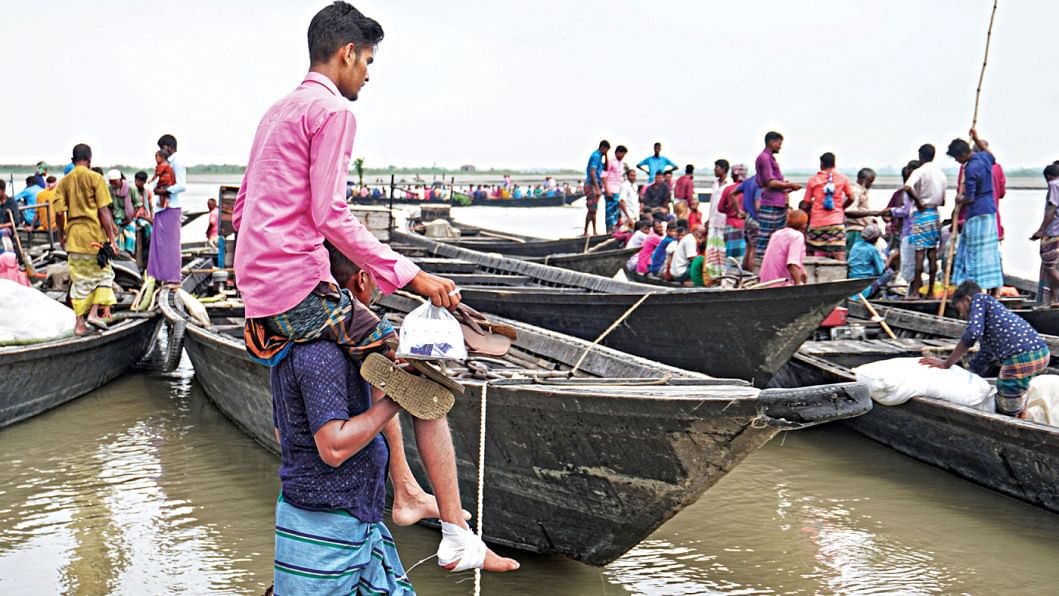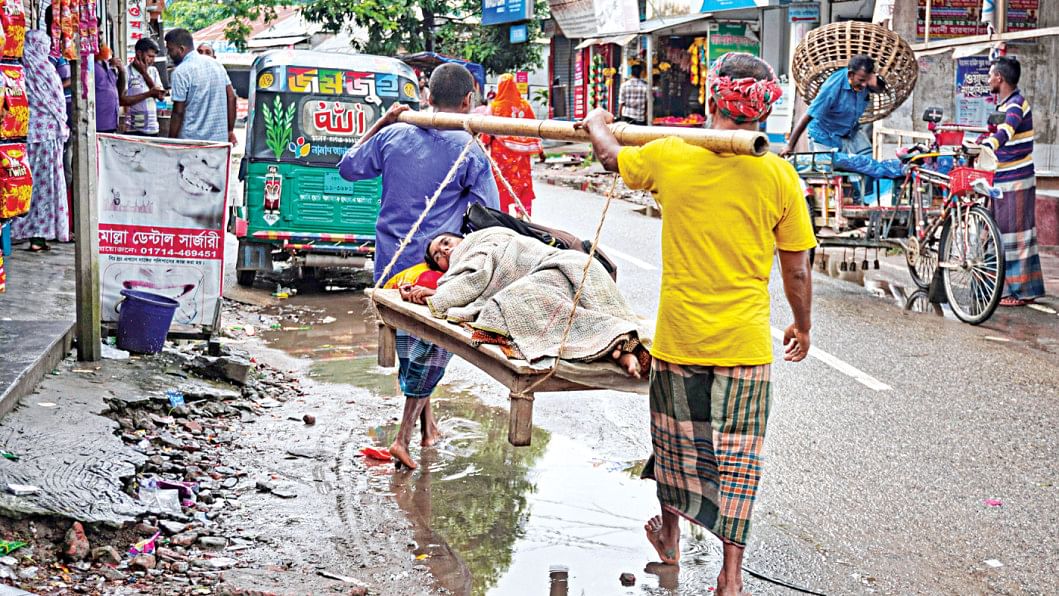The forgotten people of Gaibandha shoals
It was September 20. The clock almost ticked past midnight at Dighalkandi shoal in the Jamuna river. Manoara Begum, 30, had been suffering from a persistent fever and cough for over two weeks. In search of treatment, she and her relatives started towards Gaibandha's Saghata upazila, a journey that took three-hours.
By the time they reached the upazila health complex, it was day break.
After reviewing her X-ray report the next-day, doctors at the facility recommended immediate transfer to Gaibandha town or Bogura, saying her situation is critical as water accumulated in her lungs.
However, even after reaching Gaibandha, a district town which ideally should have better facilities, treatment remained elusive. Doctors at a local hospital informed Manoara's family that she needed to be moved to Rangpur for more advanced medical care, as their facilities were insufficient to address her deteriorating condition.
This was not an option for her poor family as they had already exhausted a substantial portion of their savings on prior hospital admissions and treatment expenses.
They returned to a relative's residence in Saghata on September 23. Manoara passed away that very night.

Her brother, Anewar Mollah, said, "Maybe my sister wouldn't have had to leave us at such a young age if emergency healthcare facilities were readily available in our shoal areas."
Contacted, Saghata upazila health and family planning officer Md Arifuzzaman said, "Manoara had a lung infection. Her oxygen saturation was very low. We gave her primary treatment, but we don't have the necessary facilities required to treat her completely, so we advised to take her to Bogura or Rangpur for better treatment."
"Besides, we don't have the facilities to conduct any major surgery at the upazila health complex," he added.
Manoara's case is not an isolated incident. People living in 160 shoals in Teesta, Brahmaputra, and Jamuna rivers under Gaibandha's Phulchhari, Saghata, Sundarganj, and Sadar upazilas have no access to emergency medical care services.
According to the data of district statistics office, 2.31 lakh people live in Gaibandha's shoal areas. The chairmen of the four upazila parishads, however, said the figure is actually around 4.5 lakh.
On 30 March last year, Helena Khatun, 25, a nine-month pregnant woman from Kalurpara shoal in Phulchhari upazila, died in the Jamuna river while being taken to hospital due to bleeding from labour.
Matbhan Begum, 45, a midwife in Kalurpara, said, "No health workers come to this area. Expecting mothers do not get any emergency treatment."
"Besides, as family welfare officials also do not come here, people do not have any awareness about birth control methods, and as such, women end up bearing multiple children despite much risk."
Josna Bhanu, 40, of the same area said, "Five years ago, my daughter Kachamati, 25, died due to lack of emergency treatment after suffering a sudden heart attack."
FAMILY PLANNING OFFICIALS A NO-SHOW
According to the Gaibandha District Nutrition Profile, around 62 percent of girls in the shoal areas get married before 18 years of age, while around 34 percent women bear children before 20. On the contrary, the figures across Rangpur division are 31 percent and 15 percent respectively.
According to the Gaibandha family planning office, 55 of the 99 posts of Family Welfare Visitor (FWV) in Gaibandha district are vacant, while 41 are currently working in the mainland. In the last five years, no FWV has been appointed for the shoal areas.
Asked, Deputy Director of District Family Planning Office Prosenjit Prannoy Mishra said, "As we do not have any union health and family welfare centre in shoal areas, we are unable to appoint any FWV there. For the last two months, some FWV have been visiting shoal areas once a month."
These FWVs are mainly responsible for counseling women about birth control methods that are provided free of cost. While they are also responsible for providing health care to adolescents, these services are not available to the nearly 4.5 lakh people living in the 160 shoals under Gaibandha.

CLINICS WITHOUT HEALTH CARE PROVIDER
According to the Gaibandha Civil Surgeon's Office, there are 320 community clinics in seven upazilas. Of these, 11 community clinics have no community health care provider (CHCP), most of those are located in the shoal areas.
Also, sub-health centres have been set up at union level to provide healthcare to rural people, each of which is supposed to have a doctor to provide 24-hour services to people.
There are no sub-health centres in 45 of the 81 unions in Gaibandha. Most sub-centres in shoal areas lack infrastructure and doctors.
DEVELOPMENT DOESN'T REACH THERE
Doctors, health assistants, and CHCPs informed the shoals are remote areas with lack of security and transport facilities, Therefore, they do not want to work there.
Contacted, Gaibandha Civil Surgeon Md Abdullahel Mafi said, "There are no emergency medical services right now, we have only community clinics at the shoals."
Asked if there is any government plan to extend emergency treatment facilities to shoal areas, the civil surgeon said, "For emergency treatment, patients from shoal areas should come to the upazila health complexes or district hospitals with boats or ambulances."
Dr Atiur Rahman, founding president of the National Char (shoal) Alliance and former governor of Bangladesh Bank, said, "Actually, people of the shoals are very unfortunate. Although there are many infrastructural developments occurring in the vicinity of shoal areas, many are still isolated."
"First of all, if people want to get good treatment, they have to come to town. So the communication system in shoal areas should be improved. Submersible roads can be built. Use of water transports should be increased."
"Secondly, good hospitals should be built at the river banks so that people from the shoals can come to avail health services easily."
"Thirdly, more community clinics should be set up in the shoal areas equipped with emergency medical facilities. If necessary, floating hospitals can be arranged in the areas and doctors should be kept there with incentives so that the people get better emergency medical care," Rahman added.

 For all latest news, follow The Daily Star's Google News channel.
For all latest news, follow The Daily Star's Google News channel. 



Comments